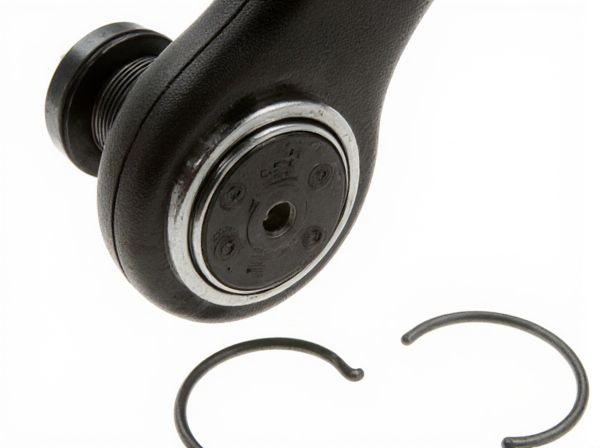
Photo illustration: Ball Joint Steering vs Kingpin Steering
Ball joint steering offers smoother and more precise control by using ball-and-socket connections that allow for multi-directional movement, improving vehicle handling and comfort. Kingpin steering relies on a fixed vertical pin around which the wheel pivots, providing durability and strength ideal for heavy-duty vehicles but often resulting in less responsive steering. Understanding the differences helps you choose the best steering system for your driving needs and vehicle type.
Table of Comparison
| Feature | Ball Joint Steering | Kingpin Steering |
|---|---|---|
| Design | Uses ball-and-socket joint for smooth, multi-directional movement. | Utilizes a fixed vertical kingpin as steering pivot point. |
| Steering Precision | High precision and responsiveness. | Moderate precision with less responsiveness. |
| Durability | Lower durability; more prone to wear and requires frequent maintenance. | Highly durable, suitable for heavy-duty and rugged conditions. |
| Maintenance | Requires regular lubrication and inspection. | Less frequent maintenance needed. |
| Applications | Common in modern passenger cars and light vehicles. | Widely used in heavy trucks and older vehicle models. |
| Cost | Generally more cost-effective for mass production. | Higher manufacturing cost but longer lifespan. |
Overview of Ball Joint and Kingpin Steering
Ball joint steering utilizes spherical bearings to allow smooth rotational movement essential for steering and suspension articulation, enhancing vehicle handling and ride comfort. Kingpin steering relies on a fixed pin serving as the pivot point for the front wheels, providing robust and durable steering mechanics primarily in heavy-duty and off-road vehicles. The fundamental difference lies in ball joints enabling multidirectional movement, while kingpin systems offer simplicity and strength with a single-axis rotation.
Historical Evolution of Steering Mechanisms
Ball joint steering emerged in the early 20th century as a response to limitations in kingpin steering, offering improved flexibility and reduced friction in vehicle suspension systems. Kingpin steering, dominant since the late 19th century, relied on a fixed vertical pin, which often resulted in greater wear and less precise handling. Advances in metallurgy and manufacturing during the 1920s facilitated the transition to ball joint designs, enabling more durable and responsive steering mechanisms critical to modern automotive engineering.
Key Components: Ball Joint vs Kingpin Systems
Ball joint steering systems utilize spherical bearings that allow for multidirectional movement, enhancing steering flexibility and reducing wear on suspension components. Kingpin steering systems rely on a vertical pin mounted between the steering knuckle and axle, providing a robust pivot point but with limited movement range compared to ball joints. The ball joint's design promotes improved vehicle handling and smoother steering response, while kingpin systems are often favored in heavier vehicles due to their durability and strength.
Steering Geometry and Performance Differences
Ball joint steering employs spherical joints allowing precise articulation and smoother steering geometry, enhancing vehicle responsiveness and minimizing tire wear. Kingpin steering relies on a fixed pivot axis, resulting in more straightforward geometry but less adaptability to road conditions, often causing increased friction and reduced steering finesse. The ball joint design supports superior camber and caster adjustments, optimizing handling performance and driving comfort compared to the older kingpin system.
Durability and Maintenance Requirements
Ball joint steering systems offer superior durability due to sealed components that resist dirt and moisture infiltration, reducing wear and extending service life. Kingpin steering requires frequent maintenance and lubrication because exposed pivot points are susceptible to corrosion and mechanical wear over time. Maintenance costs tend to be lower for ball joint systems owing to their longer replacement intervals and enhanced reliability.
Handling and Ride Quality Comparison
Ball joint steering systems provide more precise handling and smoother ride quality due to their ability to allow for multi-axis movement, reducing friction and improving responsiveness. Kingpin steering, while robust and traditionally used in heavy-duty vehicles, tends to offer less refined handling and a stiffer ride because of its simpler, pivot-based design. The ball joint setup enhances vehicle stability and comfort, making it preferable for modern passenger cars seeking superior steering feel and ride comfort.
Applications: Passenger Cars vs Heavy-Duty Vehicles
Ball joint steering systems are predominantly used in passenger cars due to their ability to provide smoother steering response, enhanced maneuverability, and better alignment correction for lighter vehicles. Kingpin steering is favored in heavy-duty vehicles like trucks and buses because of its robustness and capacity to withstand higher loads and stresses, ensuring durability and reliability in demanding operational environments. The choice between ball joint and kingpin steering hinges on vehicle weight, operational conditions, and performance requirements tailored to either passenger comfort or heavy-duty endurance.
Advantages of Ball Joint Steering Systems
Ball joint steering systems offer improved maneuverability and smoother steering response due to their ability to pivot in multiple directions, enhancing vehicle handling compared to kingpin steering. These systems reduce maintenance requirements by minimizing the number of components exposed to wear and tear, leading to increased durability and reliability. The compact design of ball joint steering allows for better suspension geometry optimization, resulting in increased ride comfort and stability.
Benefits and Limitations of Kingpin Steering
Kingpin steering offers increased durability and superior load-bearing capacity due to its robust vertical pivot design, making it ideal for heavy-duty vehicles and off-road applications. However, it has limitations such as higher maintenance requirements, increased steering effort, and reduced precision compared to ball joint steering systems. The traditional kingpin setup also tends to be heavier and less adaptable to modern suspension geometries, impacting vehicle agility and comfort.
Choosing the Right Steering System for Your Vehicle
Ball joint steering offers enhanced maneuverability and smoother handling, making it ideal for passenger cars and light trucks that require precise control and comfort. Kingpin steering provides superior durability and load-bearing capacity, preferred for heavy-duty vehicles and off-road applications where robustness and reliability under harsh conditions are essential. Selecting the right steering system depends on vehicle type, driving conditions, and maintenance preferences to optimize performance and safety.
 caratoz.com
caratoz.com